THE IDEAL WINE SERVING TEMPERATURE
The serving temperature of wine can amplify good or bad elements in wine. In general, white wine and rosé are served much cooler than red wine. The golden rule with wine is to avoid extreme temperatures. In other words, don’t serve red wine too warm and white wine too cool. However, when in doubt it is always better to serve a wine a bit too cold instead of too warm. The wine will warm up in the glass. A low temperature will emphasize the tannin. That’s why it is recommended to keep wines with a lot of tannin fairly warm. However, when the temperature of a red wine reaches over 20°C the alcohol begins to evaporate and sting unpleasantly. When a white wine is chilled below 8°C it loses its aroma.
Serving temperatures for red wine:
- Fresh, fruity, light and supple wines: 14° – 16°C / 57.2° – 60.8°F
- Full-bodied, spicy, fairly complex wines: 16° – 18°C / 60.8° – 64.4°F
- Powerful, concentrated, robust wines: 16° – 18°C / 60.8° – 64.4°F
- Lush, sweet red wines: 16° – 18°C / 60.8° – 64.4°F
Serving temperatures for white wine:
- Fruity, fresh, medium-dry white wines: 7° – 9°C / 44.6° – 48.2°F
- Champagne and sparkling wines: 8° – 10°C / 46.4° – 50°F
- Fresh, light, fruity, dry white wines: 8° – 10°C / 4° – 50°F
- Rosé wines: 8° – 10°C / 4° – 50°F
- Lush, sweet white wines: 10° – 12°C / 50° – 53.6°F
- Full-bodied, aromatic, dry white wines: 10° – 12°C / 50° – 53.6°F
- Very full-bodied, complex, dry white wines: 12°C / 53.6°F
WHY WE USE ‘CHEERS’
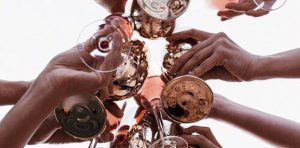
‘Cheers!’ The history behind raising our glass and saying cheers. In the Netherlands they say ‘Proost’, in France it’s ‘Santé’, in Italy it’s ‘Salute’ and in Czech it’s ‘Na zdravi’. Wherever you go in the world, it’s a general use to say ‘cheers’ before sipping your wine at dinner or taking a shot of tequila with friends in the bar. But did you ever wonder why we say cheers?
There are a few various stories regarding toasting. The first story is that toasting is originated with the ancient Greeks and Romans. During ceremonial banquets, they gave offerings to the gods. Wine was poured, glasses were raised and those present would announce respect to the dead and to the health of the living. On the other hand, some say that during ancient sacrificial libations a sacred liquid was offered to the gods: blood or wine in exchange for a wish summarized in the words ‘to your health’.
According to other stories, the wealthy would make a toast to indicate that the glasses were made of crystal. Or because in the early years people would often share their wine and drink from just one glass. When they started to all have their own glass, the glasses were brought together once more to emphasize the unity and group feeling.
The word ‘toasting’ literally comes from the ancient practice to add spiced toast to your wine as the seasonings and charcoal from the toast flavoured and tempered the wine.
All in all, nowadays we cheer to wish each other good health, or to celebrate a special happening, or simply because we’re happy to be together. But next time when you raise your glass and say ‘cheers’, you’ll know it’s a movement with lots of history.
WHAT ARE TANNINS?
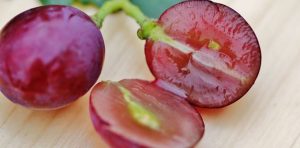
Tannins in a wine is indicated on almost every red wine label. What are tannins and is it beneficial for the flavour of wine or is it solely to ensure that wine is preserved longer?
Tannins are elements in wine that originates from the wooden barrels in which wine was aged or from grape skins, seeds and stems during the yeasting process. In some cases, tannins are added artificially.
Tannins have a few important functions when it comes to making wine. By putting a stop to the growth of bacteria, tannins ensure that wine is preserved longer. It causes the wine to age gradually and the development of flavours and aromas to happen in the desired tempo.
In principle, a winemaker can decide how much tannins are added to a wine. This occurs during the yeasting process of the grape skins. The longer the yeast process with the skins, seeds and stems continues, the more tannins are released in a wine, the darker the wine colour gets. The large quantity of tannins ensures for a longer preservation of wine. However, it also causes the duration of the aftertaste to be longer.
Tannins occur in red wine as well as in white wine. However, red wine contains more tannin than white wine. This is because of the way red wine is produced. Compared to white wine the grape skins, seeds and stems in red wine stay in red wine for the total duration of the yeasting process. With white wine, the grape skins, seeds and stems are immediately separated after being pressed for grape juice. For this reason, white wine can’t be preserved as long as red wine.
The best way to experience the flavour of tannins, is to bite down on a grape seed and hold it in your mouth or drink a big sip of cold tea. The flavour of this is bad and the corner of your mouth will want to contract. When people taste wine that contains a lot of tannins, it will be described as sour. However, sour would not be the correct word to describe this flavour. A more fitting description would be, dry or bitter. A surplus of tannin causes a wine to taste hard and dry. However, nice and ripe tannins contribute to a nice structure of wine when it’s in the mouth. That’s why it is essential for the winemaker to find a good balance between a long shelf-life and the flavour of the wine.
HOLDING & SWIRLING WINE
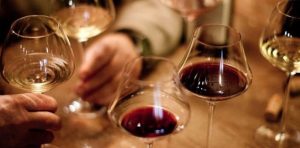
How do you drink your wine like an expert? It all starts with the beginning: How do you hold and swirl your glass? There are very different manners of holding & swirling wine. By the stem, the bowl and some even hold their glass with two hands. But how do we hold our glass according to the latest etiquette?
HOLDING WINE LIKE A PROFESSIONAL
If you want to hold your wine like an expert, hold the glass by the stem between your thumb and first two fingers. When you hold your glass by the bowl, your hands will warm up the wine and alter the taste of the wine. As wine becomes warmer, the alcohol evaporates at a quicker pace and more complex flavours will disappear. This results in a more flat wine. Of course, this is mainly important with chilled wine. If you hold your wine by the stem, you’ll keep your wine at a proper temperature and drink it at its best. A nice benefit of holding your glass by the stem is that you’ll prevent the bowl of fingerprints and that you’ll see the true colour of the wine through your glass.
SWIRLING WINE
Holding your glass by the stem will also make it easier to swirl (or swing) your wine. Just rotate your wrist so the wine swirls around the bowl of your glass. When you swirl, oxygen is added to the wine which helps the wine to release its aromas. Therefore wine experts dip their nose into the glass after swirling, as this unlocked flavours. Your wine will taste even better after! This can also be done by a swirling carafe! But does all this really matter? On some occasions it does, but when you’re with friends at home on a Friday evening, we think it doesn’t matter as long as you’re enjoying your wine and evening.
WHEN IS A WINE BAD?
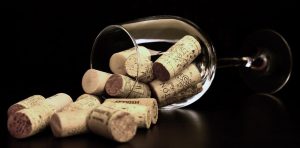
RECOGNIZING A BAD WINE
Have you ever tried a wine with cork taint? Once you do, you’ll immediately know it’s bad. We call this a ‘wine fault’. A wine can have a flavour that doesn’t suit your taste, but that doesn’t necessarily make it a bad wine. For example when there is an imbalance between the tannin, alcohol, acidity and sweetness. This gives it a bad taste, but it doesn’t make the wine faulty. A real wine fault is, for example, a wine with cork taint, oxidized wine, moderated wine or when there are tiny bubbles forming in the wine.
WINE WITH CORK TAINT
A wine with cork taint will usually have a very stale smell. Think of old basements, wet cardboard, a wet dog or an old kitchen wipe. All the aromas of fruit and herbs will be gone from the wine. If you still have the guts to try the wine after being confronted with that smell, it will most likely taste like cork. Very dry and bitter.
OXIDIZED WINE
When a wine is oxidized you will smell it immediately. The wine has very little aroma left and will only smell a bit of overripe apples and nuts. Or old sherry. Not a smell you want to go for! It will have a very typical nutty character and a bit of a chemical tone in the flavour.
MODERATION
This is a fancy word for saying the wine has been kept wrong over time. For example the wine rack in your living room. How long has the wine been there? How about the temperature differences in the room? A wine that has been in a warm environment for too long can get a bit of a ‘cooked’ character. The wine gets an aroma of dried fruits and roasted nuts, instead of fresh fruits. This is fine for a port wine, but doesn’t belong to a ‘normal’ red wine.
BUBBLES FORMING IN WINE
Sometimes it happens that tiny bubbles start to form in the wine that don’t belong there. This is definitely a wine fault. It means that not all the yeast cells were done yeasting when the wine was made. This means they continued yeasting in the bottle. The process of yeasting in the bottle creates the little bubbles that come free when the wine is poured into a glass. Usually, this won’t influence the flavour of the wine too much, but it can happen that it causes an imbalance in flavour. In this case, there is only one solution: pour in through the sink.
FOOD AND WINE PAIRING BASICS
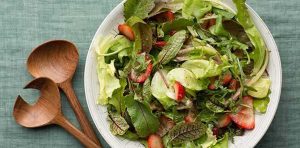
Developing a great food and wine pairing is easily done by experimenting with 6 main basic flavour profiles. It’s time to take a closer look at the fundamental flavour profiles for food and wine pairing and why it works. Match your food and wine like you’re a professional chef or a sommelier.
The first thing is the six basics when it comes to food and wine pairing:
- Fatty and sweet foods pair well with acidity in wines.
- Fatty foods need either an acidic or high alcohol wine, otherwise, the wine will taste flabby.
- Sweet food can perfectly be balanced by a bitter wine.
- Salty shouldn’t compete with acidity in the wine. Use sparingly as necessary to keep sharpness in the meal.
- Sweet food/wine benefits from a little acidity.
- Alcohol can be used to cut through fatty foods or balance a sweet dish.
To understand more about what’s going on structurally with wine & food pairing, regional pairing often are perfect. An elegant Italian wine combined with delicious Italian food… Get it? Be playful when it comes to food pairing and discover your taste when it comes to regional tasting.
Unlike bitter, acidity can be added together with food and wine and will create the basis of what wine people think about when selecting a wine with dinner. If the wine has less acidity than the food, the wine will taste flat. An easy visualisation for acids out-of-balance is a glass of oaked warm climate chardonnay with a vinaigrette salad. When pairing a dish with wine, consider the acid balance between the food and the wine.
If you love maple bacon, candied pecans and salted caramels, a wine and food pairing of a sweet wine with a salty food will probably delight you. Pair Riesling with Asian foods such as fried rice or Pad Thai, or try one of my favourite “low calorie” desserts of pretzels and tawny port.
Grab a big thick piece of fatty something-or-other and pair it with a wine with lots of tannin. This is the classic steak with red wine-food pairing. Take a red wine such as an Italian Sangiovese with lots of cherry flavours and pair the wine with a herbed potato croquette, roasted red tomatoes and rocket (a classic Tuscan Secondi). Suddenly you have a dish that has the tannin balanced with the fat in the croquette and a congruent flavour in the dish and wine (tomato and cherry) that elevate each other.
Nothing like a glass of champagne to cut the fat. A high acid drink will add a range of interesting flavours to a lipid heavy dish. This is why white wine butter sauce is popular. The white wine in the butter sauce livens up the whole dish. So when you are in a situation where there is something fatty like cheesecake, get a glass of something bubbly and zippy.
The alcohol category is a bit of a strange one. The alcohol taste actually comes across as acidity so a lot of the same ideologies of the Acid + Fat category pass over into Alcohol + Fat. The primary difference is that a high alcohol drink should not be used as a palate-cleanser because that will eff you up. Instead, look at an alcohol + fat category as a way to mitigate high-speed food consumption. A glass of 17% ABV zinfandel will greatly slow down the rate at which you consume your pepper steak.
SPICE AND WINE PAIRING
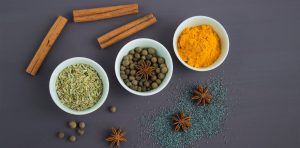
This week is national herb week and what better way to celebrate this than by explaining the best combination between wine and herbs and spices? We introduce you to the ultimate spice and wine pairing guide by Wine Folly. In this guide, they explain exactly which herbs and spices fit with your wine. They also explain why it is important to pair wine with herbs and spices.
Wine folly explains that the magic behind spice and wine pairing starts with aroma compounds found in both spices and wine. Many herbs and spices share the same aroma compounds as wine, not surprising is it? A good example is matching a black pepper with Syrah; both wine and spice contain the spicy-but-floral compound called rotundone. When you match like flavours together they magnify each other. This type of pairing is called a congruent pairing and it’s the theory behind matching wine with spices and herbs.
Basil, Mint, Cilantro, Shiso, Chervil – Highly aromatic fresh green, citrus, and minty herbs
Thai Basil – Riesling, Moscato
Mint – Merlot, Syrah, Pinotage
Shiso – Rosé, Gamay
Basil – Soave, Gavi, Pinot Grigio
Chervil – Albariño, Sauvignon Blanc, Chenin Blanc
Sage, Rosemary, Lavender, Fir – Dried resinous floral herbs
Sage – Riesling, Viognier, Marsala
Rosemary – Shiraz, Zinfandel, Carignan
Lavender – Monastrell, Rosé, Gewürz
Baby Leaf – Syrah, Nebbiolo
Fir – Tempranillo, Sangioverse
Oregano, Thyme, Marjoram, Tarragon, Bay Leaf, Parsley, Dill – Pungent earthy green herbs
Oregano – Cabernet Franc, Carménère
Thyme – Pinot Noir, Zweigelt
Tarragon – Chardonnay, Marsanne
Marjoram – Grüner Veltliner
Dill – Sémillon, Pinot Noir
Garlic, Shallot, Chive, Leek, Onion – Umami-rich, pungent, sulfury alliums
Garlic – Grüner Velt, Sauvignon Blac
Shallot – Chardonnay, Pinot Noir
Chive – Muscadet, Trebbiano
Leek – Colombard, Picpoul
Onion – Zinfandel, Negroamaro
Coriander, Cumin, Caraway – Savory, umami-rich brown spices
Coriander – Malbec, Mourvèdre
Cumin – Sparkling Rosé, Bordeaux
Caraway – Gewürztraminer, Riesling
Mustard, Horseradish, Szechuan Pepper, Wasabi – Sharp, clean piquant (spicy) spices
Mustard – Pinot Gris
Horseradish – Riesling
Szechuan Pepper – Schiava, Lambrusco
Wasabi – Chenin Blanc
Cinnamon, Allspice, Vanilla, Clove, Fenugreek, Nutmeg, Mace – Sweet, brown, baking spices
Cinnamon – Zinfandel, Amarone, GSM
Allspice – Pinot Noir, Riesling
Vanilla – Port, Banyul
Clove – Pinot Noir, Gewürztraminer
Fenugreek – Gewürztraminer, Riesling, Pinot Gris
Anise, Licorice, Star Anise, Black Cardamom, Fennel – Aromatic, terpene-dominant, incense spices
Anise – Barbera, Syrah, Moscato
Licorice – Barbera, Syrah
Star Anice – Brachetto d’acqui
Black Cardamom – Gewürztraminer, Lemberger
Fennel – Riesling, Dolcetto
Red, White, Pink and Black Pepper – Piquant (spicy), umami-rich, rotundone-dominant spices
White pepper – Grüner Veltliner
Pink pepper – Sparkling Rosé
Black pepper – Cabernet Sauvignon, Syrah, Petite Sirah, Port
Paprika, Cayenne Pepper, Ancho Pepper, Aleppo Pepper – Piquant (spicy), smoky red pepper
Paprika – Malvasia
Cayenne Pepper – Lambrusco Amabile
Ancho Pepper – Gewürztraminer
Aleppo Pepper – Riesling
Ginger, Galangal, Turmeric, Green Cardamon – Perfumed, sharp, citrus-like spices
Ginger – Riesling, Sauternais
Turmeric – Chardonnay, Sémillon
Green Cardamom – Viognier, Zinfandel
WHICH COUNTRY MAKES THE BEST WINE?
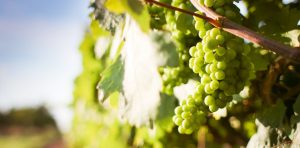
Of course, this is a very interesting question to ask yourself. It is all about defining what question you’re actually asking. So when do you think a wine is the ‘best wine’? Is the most expensive wine also the best wine? Or is the country that produces the most wine automatically the country with the best wine?
THE THREE BIG WINE COUNTRIES
France, Italy and Spain are the three countries that produce the most wine in litres. Together they produce more or less half of all the wine that is produced in the world. In France for example, you will find the most expensive wines in the world. Besides all the beautiful and expensive wines these countries also produce a lot of cheap wine that you can buy in your everyday corner store. So if you look at the quality they are not consistent at all.
CONSTANT WINE QUALITY
So which countries, you may ask, are consistent in their quality? According to Jeroen, these are countries like for example Chili, New Zealand and Austria. The most important is that the most expensive wines are definitely not always the highest in quality. Go with your senses. Smell, taste, experience and enjoy your wines and decide for yourself. In the end, not everybody has the same taste in wine.
CORK OR SCREW TOP?
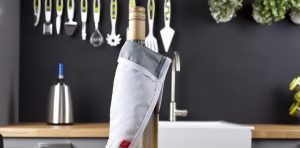
SCREW TOPS ON A WINE BOTTLE
The most significant difference between the cork and a screw top is that a screw top will shut the bottle completely airtight, whereas a natural cork will leave a very tiny opening for oxygen to enter the bottle. This means that wine in a bottle with a screw-top will no longer change once it is bottled. This is completely fine for wines that will be consumed within the first few years after the harvest, especially wines that are supposed to be fresh and fruity.
WINE BOTTLES WITH NATURAL CORK
A wine that is bottled with natural cork will be exposed to a certain amount of oxygen, even after the cork is put on top. This is called oxidation. Oxidation is not harmful and can even benefit the wine. Wine is a product that will keep developing (or ageing) in the bottle. By adding a tiny bit of oxygen through the cork the wine will go through slight a change over time. Unfortunately, it can happen that the cork has cork taint, but this only happens on very few occasions.
AGEING IN THE BOTTLE
Wines that are made to age in the bottle and will benefit from a bit of oxygen during the ageing process are bottled by cork. Wines that are made for ‘faster’ consumption and have a fresh and fruity taste will more and more often get a screw top.
WHICH IS PREFERRED?
Most wine connoisseurs will still prefer a natural cork over a screw top. This is partially because screw tops are, wrongly in our opinion, still associated with cheap wine. If a wine does not have a natural cork, they would still prefer a plastic cork than a screw top. Of course for a lot of other people the screw top has preference because you can open it at any time without an opener.
SAVING AND STORING WINE
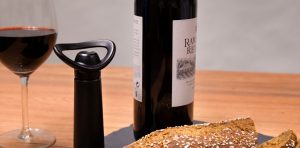
HOW DO I GO ABOUT STORING WINE?
Storing wine properly is of great importance. If you store your wine in the wrong way, it will go bad and of course, we want to avoid big disappointments when opening a bottle. Wine is influenced by light, temperature and vibrations. Therefore there are certain ‘rules’ to storing your wines:
- Store the wine in a dark place.
- Is the bottle sealed by a cork? Store the bottle laying down.
- Store the wine at a constant temperature of about 12 degrees Celsius.
- Avoid big temperature changes.
- Let the wines rest, don’t move them about too often.
HOW LONG CAN I SAVE AN OPEN BOTTLE OF WINE?
In general, you can save an open bottle of wine about 1 or 2 days after opening. This is when you seal the bottle properly after pouring. Use the original cork, wine stoppers or the original screw top. You should save the wine cool, so if you don’t have a basement or special wine climate cabinet, the fridge is your best option. This also goes for red wine. When a wine is stored in a warm space the quality and taste will decrease even faster. Once opened, make sure you store your wines standing up. It’s the oxygen that influences the taste of the wine. When a bottle is laying down, the surface becomes bigger and therefore oxidation goes faster. To slow down oxidation it is advised to remove as much air from the bottle as possible. This is very easily done with the Wine Saver. This device vacuum seals the wine, which makes it last for about 7 to 14 days!
WHICH WINES CAN I STORE LONGER?
The time over which you can store a wine without the taste decreasing depends on among others the grape, the production process and the bottling. It is safe to say that wine you buy in a supermarket is not meant to be saved for longer than 1 or 2 years.
Then there are certain storage wines, or as the French call them ‘Vin de Garde’. These wines are specially produced to be stored for a long time. They keep evolving when they are in the bottle. Often these wines won’t taste too nice in the first few years after bottling. To really balance the flavour they need to sit in the bottle and breathe through the cork. Storage wines are often red wines. White wines can usually not be saved as long as red wines as they have less tannin.
Rose and sparkling wines can generally not be stored very long. Of course, there are exceptions to this rule, but most of these wines you can best consume within 1 or 2 years.
